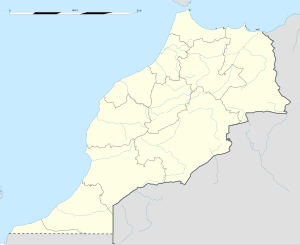Tamegroute
|
Tamegroute تامكروت |
|
|---|---|
 |
|
| Location in Morocco | |
| Coordinates: 30°16′N 5°40′W / 30.267°N 5.667°WCoordinates: 30°16′N 5°40′W / 30.267°N 5.667°W | |
| Country |
|
| Region | Drâa-Tafilalet |
| Population (2004) | |
| • Total | 6,000 |
| Time zone | WET (UTC+0) |
| • Summer (DST) | WEST (UTC+1) |
Tamegroute (also spelled Tamgrout; Arabic تامكروت) is a village located in the Draa River valley in southern Morocco. It historically served as a hub of learning and religion through its famous Sufi zawiya. This was a historical center of the Nasiriyya order, one of the most influential (and at one time one of the largest) Sufi orders in the Islamic world. Tamegroute's glazed ceramics are also very well known.
Tamegroute has been a religious center since the 11th century. The Nasiriyya zawiya was founded in the 17th century as the seat of the religious (Sufi) brotherhood of the Nasiriyya. Tamegroute had a religious school made famous by Abu Hafs Umar b. Ahmed al Ansari in 1575–76. The Nasiriyya order took its name (and its reputation) from founder Sidi Muhammad bin Nasir al-Drawi (1603–1674), who took over teaching at the Tamegroute zawiya in the 1640s. Since that time the leaders of the zawiya have been descendants of bin Nasir without interruption from father to son until the present day. Sidi Muhammad bin Nasir was a theologian, scholar and physician, especially interested in mental disorders. He wrote several works of fikh, some poetry, and hundreds of letters and treatises on Islamic law. He followed and extended the teachings of Shadhili and under his leadership the Nasiriyya became the 'mother'zawiya' of Sufi islam in the Maghreb with several branches in different parts of the country, including the zawiya of Irazan in the Sous valley where 500 students were financed by the brotherhood.
He was succeeded by his son Ahmad (1647–1717) who made six pilgrimages to Mecca and made each of these pilgrimages into a journey of several years. Sidi Ahmad bin Nasir traveled to Ethiopia, Arabia, Egypt, Iraq and Persia. During his travels he took the opportunity of establishing new branches of the Sufi brotherhood. He wrote a voluminous series of memoirs of his journeys called the Rihla (partly translated by A. Berbrugger in 1846) and he brought back numerous works from all parts of the Islamic world. The brotherhood decided, already in the 17th century to found a university of the Quran. That university received, right from the beginning, more than 1500 students from countries in the Middle-East and West Africa.
...
Wikipedia

